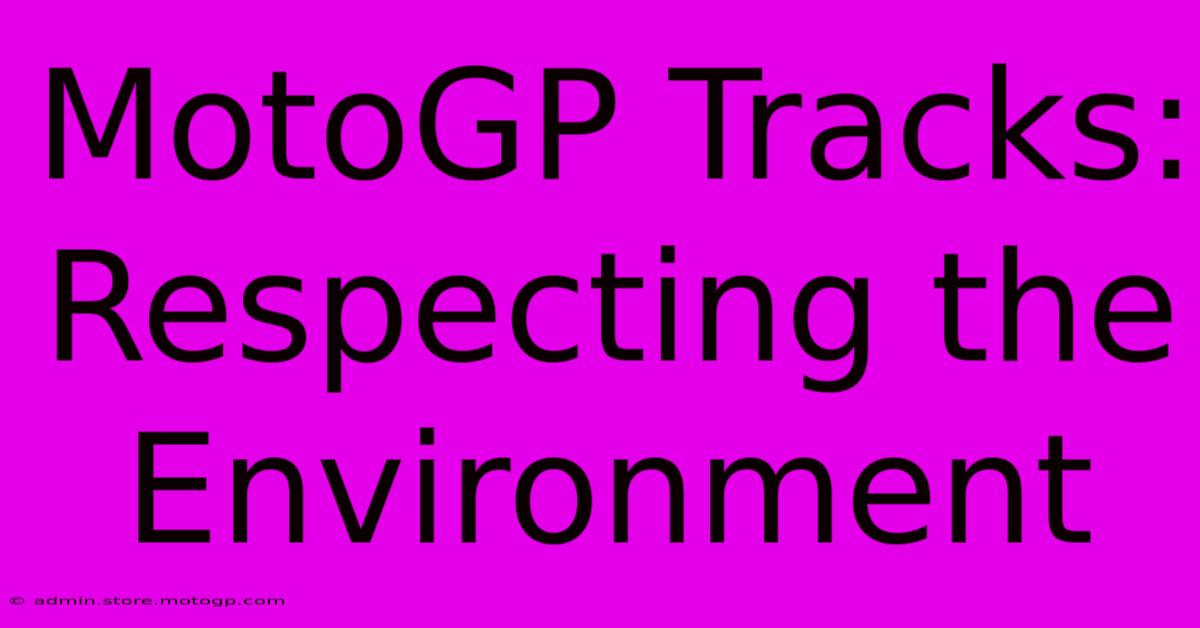MotoGP Tracks: Respecting The Environment

Table of Contents
MotoGP Tracks: Respecting the Environment
The roar of the engines, the smell of burning rubber, the breathtaking speed – MotoGP is a spectacle that captivates millions. But behind the thrill of the race lies a significant environmental footprint. Fortunately, increasing awareness and proactive measures are transforming how MotoGP circuits approach sustainability, paving the way for a greener future for this exhilarating sport.
The Environmental Impact of MotoGP
MotoGP events, while thrilling, aren't without their environmental consequences. Consider these key factors:
Carbon Emissions: The primary concern is the considerable carbon footprint generated by the travel of teams, spectators, and freight. Air travel, the transportation of bikes and equipment, and the energy consumption at circuits all contribute significantly to greenhouse gas emissions.
Waste Generation: Large-scale events like MotoGP inevitably produce substantial waste, including plastic bottles, food packaging, and discarded materials. Improper waste management can lead to pollution and environmental damage.
Noise Pollution: The powerful engines generate considerable noise pollution, impacting local wildlife and communities surrounding the circuits. While not directly related to environmental damage in the traditional sense, it's a significant consideration of the overall impact.
Land Use and Habitat Disruption: Constructing and maintaining racetracks can lead to habitat loss and disruption of local ecosystems. The impact depends heavily on the location and planning processes involved.
Green Initiatives on MotoGP Tracks
Thankfully, the MotoGP community is increasingly recognizing its environmental responsibility. Several initiatives are underway to minimize the impact of races and promote sustainable practices:
Renewable Energy Sources: Several circuits are investing in renewable energy sources like solar and wind power to reduce their reliance on fossil fuels. This shift towards cleaner energy sources is a significant step towards reducing the carbon footprint of the events.
Sustainable Transportation: Encouraging fans to utilize public transport, cycling, or carpooling to reach the circuits helps to reduce traffic congestion and associated emissions. Some tracks are also exploring electric vehicle charging infrastructure.
Waste Management Programs: Implementing robust waste management strategies, including recycling and composting programs, is vital to minimize waste sent to landfills. Many circuits are actively promoting waste reduction and responsible disposal methods.
Carbon Offset Programs: Several teams and organizers are participating in carbon offset programs, investing in projects that reduce greenhouse gas emissions elsewhere to compensate for the carbon footprint of their events. These programs aim to neutralize the impact of races on the environment.
Environmental Impact Assessments: Conducting thorough environmental impact assessments before and during construction of new tracks or renovations is crucial for minimizing the ecological disruption and identifying strategies for mitigation.
The Future of Sustainable MotoGP
The future of MotoGP hinges on continued commitment to environmental sustainability. Further development of green initiatives will be crucial. This includes:
- Investing in sustainable fuels: Researching and implementing the use of alternative and sustainable fuels in racing bikes is a game-changer.
- Promoting sustainable materials: Utilizing eco-friendly materials in the construction and operation of circuits.
- Educating fans: Raising awareness among fans about environmental issues and promoting responsible behavior at MotoGP events.
- Collaboration and Transparency: Collaboration between teams, organizers, circuits, and environmental organizations is crucial to develop and implement effective sustainability strategies.
Conclusion:
The path toward a greener MotoGP is challenging but achievable. By embracing innovative solutions, promoting responsible practices, and fostering collaboration, the sport can continue to thrill audiences while minimizing its environmental footprint and leaving a positive legacy for future generations. The commitment to sustainability is not just a trend; it's a vital step towards ensuring the long-term viability and positive image of MotoGP.

Thank you for visiting our website wich cover about MotoGP Tracks: Respecting The Environment. We hope the information provided has been useful to you. Feel free to contact us if you have any questions or need further assistance. See you next time and dont miss to bookmark.
Featured Posts
-
The Science Of Speed Deconstructing Moto Gp Engines
Feb 19, 2025
-
Own A True Racing Legend Moto Gp Motorcycle
Feb 19, 2025
-
Malaysia Moto Gp A Must See Event
Feb 19, 2025
-
Moto Gp Tracks Vip Access And Hospitality
Feb 19, 2025
-
Funniest Moto Gp Commentary Slip Ups
Feb 19, 2025
